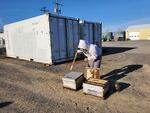In this monthly rundown, we feature the most interesting, wondrous and hopeful science coming out of the Pacific Northwest, from Jes Burns, creator of “All Science. No Fiction.” And remember: Science builds on the science that came before. No one study tells the whole story.

This image released by NASA shows Jupiter's moon Europa with its signature red scars.
Courtesy NASA/JPL/Galileo
Ice with a dash of salt
Of all the non-Earth planets and moons in our solar system, Jupiter’s watery-moon Europa is considered to have the best chance of harboring life. It’s famous for a mysterious series of reddish-colored veins scarring its icy surface.
Now researchers at the University of Washington think they might know what those veins are made of. They’ve discovered two (and possibly three!) new chemical structures — called hydrates — for saltwater that only form at extremely high pressure and low temperatures.
They discovered this by squeezing a teeny-tiny drop of salt water between two teeny-tiny diamonds and using a microscope to watch the crystal structure that formed.
The next step for the researchers is to make a larger quantity of the new hydrates to see if their signatures are indeed a match for the red streaks on Europa.
Read more in the Proceedings of the National Academy of Sciences here.
Rings of fire
Remember that heat wave that hit the Pacific Northwest a couple years back — when temperatures in places like Portland were above 110 degrees? We knew it was weirdly hot, but just how unusual was it?
Well, researchers at the University of Idaho and Columbia University have found physical evidence that temperatures likely haven’t been that hot in our region for at least 1,000 years.
The evidence came in the form of tree rings sampled in Idaho, Oregon, Washington and British Columbia going back to the year 950. Using a technique called “blue intensity,” (which measures the reflectivity of visible light to gauge a common biological response of trees to heat) they were able to determine the average temperature of any year they had a tree ring for. They found that the heat wave of 2021 was by far the hottest warm season on record — by more than 3 degrees F.
Read the paper from the journal Climate and Atmospheric Science here.

In this photograph released by the University of Idaho, study author Karen Heeter takes a core sample from an old mountain hemlock near Crater Lake, Oregon, where at least one tree dated to the 1300s.
Courtesy Grant Harley/University of Idaho
Early human migration windows
For a long time, scientists believed early humans first crossed from Asia to North America about 13,500 years ago via the Bering Land Bridge (between what’s now Russia and Alaska). But recent archeological evidence has suggested an earlier migration, which is thought to have occurred along the Pacific Northwest coast instead of inland.
Researchers from the U.S. Geological Survey, Oregon State University and the University of Oregon say some relatively-flat coastal ice would have been needed because a northern current would have made travel south via boat very difficult. And they’ve now identified two historic windows where sea ice conditions would have been favorable for south-bound foot traffic along the coast.
They analyzed sediment cores collected from the Gulf of Alaska and found traces of algae that grows around sea ice. The algae was in layers dated from 22,000 to 24,500 years ago and from 14,800 and 16,400 years ago. These windows of possible coastal migration mesh well with the earlier dates of some early-human sites around North America.
Read the study in the Proceedings of the National Academy of Sciences here.

In this photo released by Washington State University, a beekeeping scientist prepares a queen bee bank near the refrigerators where the banks were stored.
Courtesy Brandon Hopkins/Washington State University
Bee banks
In many ways honeybees are the engines that make our agricultural food systems run — and they’re in trouble. Parasites, pesticides and climate change have contributed to staggering colony losses.
Beekeepers employ many strategies to keep their colonies strong, including “queen banking,” a process of maintaining and storing excess queen bees in cages over the summer so they’re available to replenish hives that fail.
Researchers at Washington State University have found a more successful and efficient way to manage the bank. By keeping the bees indoors and applying a little refrigeration, they recorded survival rates more than 15% higher than the current ambient-temperature method. The refrigeration also cut down on the amount of non-bee (human) maintenance needed to keep the queens healthy.
This new discovery may prove useful as climate change makes the old methods of queen banking outdoors in increasingly hotter conditions more difficult.
Read the paper in the Journal of Apicultural Research here.
Moist soil — better than it sounds
With the impacts of climate change being felt more and more every day, the urgency of understanding how our planet stores and processes carbon is increasing. The ocean, by far, stores the most carbon, but soil runs in second place.
A team of scientists, including researchers at Oregon State University and the Pacific Northwest National Laboratory, is trying to understand what characteristics of soil most influence how much and how long carbon is stored in the soil. They initially believed temperature or mineral content of the soil would be the drivers, but that didn’t turn out to be the case.
After analyzing 400 soil core samples from across the Lower 48, they found that moisture ended up being a huge driver. The deeper the water in the soil went, the further down it pushed organic material (carbon). And the deeper that carbon was pushed, the longer the soil is able to store it. Ultimately, soil processes carbon differently depending on whether it’s in arid or humid climates.
And with climate change creating more arid conditions across the country, some fear this means the soil will sequester less and less carbon as the planet heats up.
Read the article in Proceedings of the National Academy of Sciences here.
